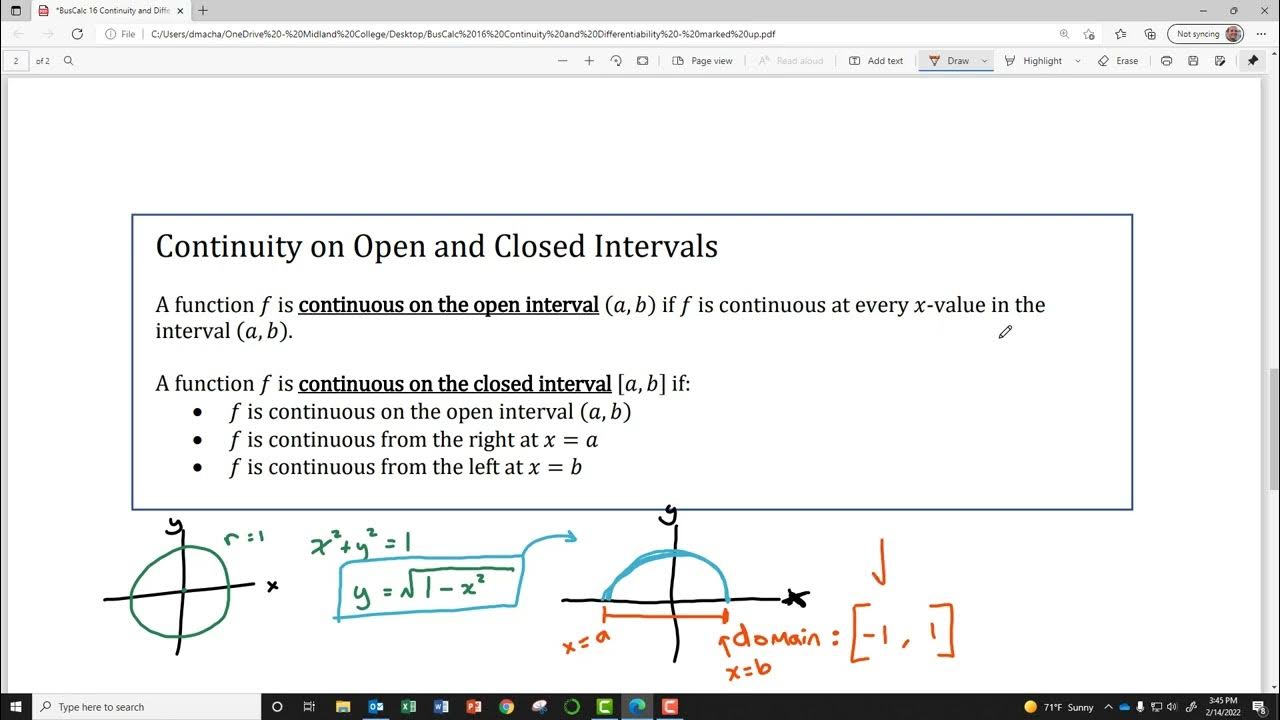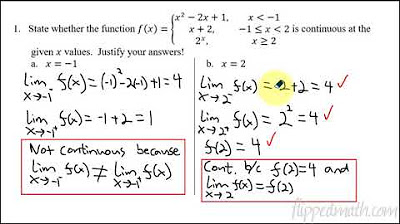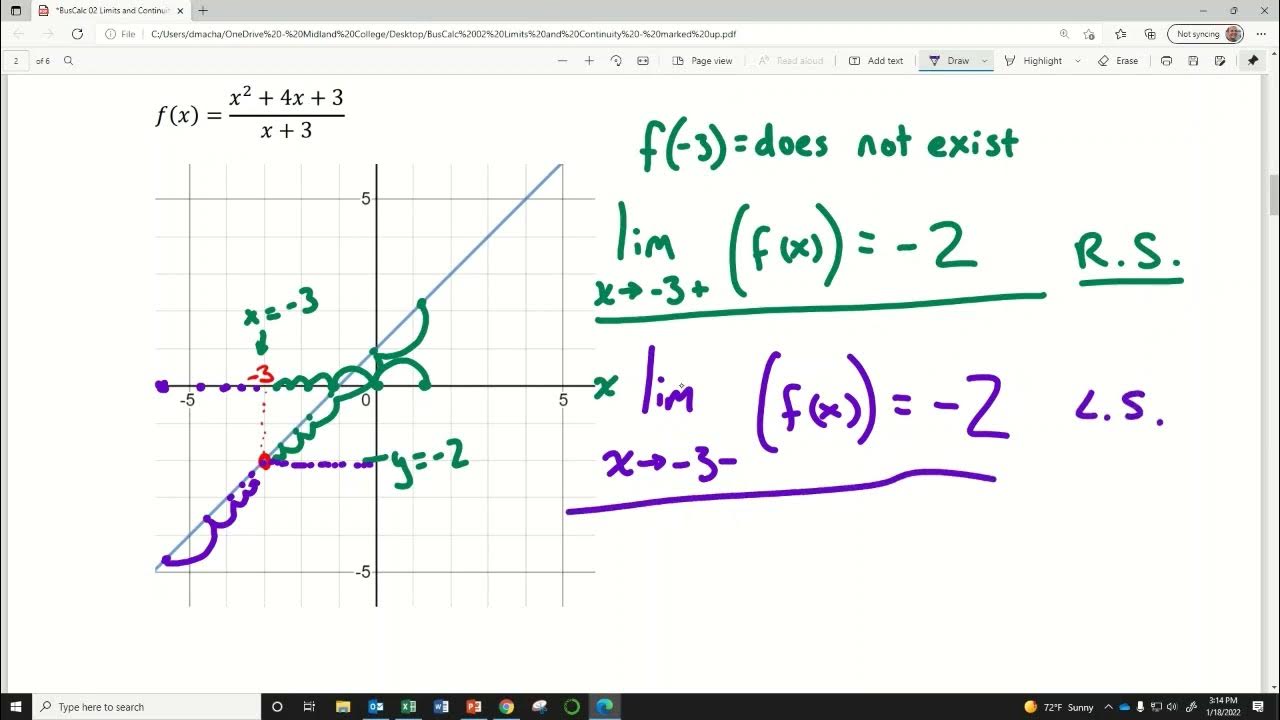Differentiability (Formal Definition)
TLDRThis lesson delves into the concept of continuity and differentiability in functions, emphasizing the importance of formal definitions. The instructor explains that continuity at a point is characterized by the limit from both directions converging to the function's value at that point. A function is continuous if the left and right limits equal the function's value at a given point. The lesson also highlights the similarity between the definition of continuity and differentiability, with the latter focusing on the derivative rather than the function itself. The instructor uses the example of a function with a discontinuity at zero to illustrate the concept.
Takeaways
- 📚 The lesson introduces the concept of continuity and differentiability in the context of functions, emphasizing the importance of understanding these concepts before delving into formal definitions.
- 🔍 Continuity is related to the limit of a function as it approaches a certain point, and it requires the function to behave the same way from both the left and the right.
- 👉 The script explains that 'a plus' signifies approaching a point from higher values (from the right), while 'a minus' signifies approaching from lower values (from the left).
- 📈 For a function to be continuous at a point 'a', the limit from the left (lim as x approaches a from the left) and the limit from the right (lim as x approaches a from the right) must both equal the function's value at that point, f(a).
- 🚫 The script uses the example of a function with a discontinuity at x=0 to illustrate that if the left and right limits do not equal the function's value at that point, the function is not continuous there.
- 🔄 The concept of differentiability is similar to continuity but focuses on the derivative of the function, requiring the derivative to be the same from both directions as it approaches a point.
- 📘 The formal definition of differentiability involves the limit of the derivative as x approaches a point 'a', which should be consistent from both directions.
- 📝 The script suggests that having a formal definition helps in understanding and identifying whether a function is differentiable at a particular point.
- 🤔 The importance of inspecting critical points in a function is highlighted, as these are the points where continuity and differentiability need to be carefully examined.
- 📉 The example given in the script points out that even if a function is continuous at many points, there can still be points of discontinuity that require special attention.
- 📚 The lesson aims to establish a parallel between the concepts of continuity and differentiability, showing that they are closely related and can be understood through similar principles.
Q & A
What is the main idea introduced in the last lesson?
-The main idea introduced in the last lesson is the concept of continuity in functions, which provides a framework to understand and articulate the behavior of functions at specific points.
Why is it important to have a formal definition of continuity?
-A formal definition of continuity is important because it allows for a precise understanding of a function's behavior at a point, especially when considering critical points where the function might behave differently.
What does the term 'limit' signify in the context of continuity?
-In the context of continuity, 'limit' refers to the value that a function approaches as the input (x) gets arbitrarily close to a certain point (a).
What is the difference between approaching a point from the left and from the right?
-Approaching a point from the left (a-) means considering values of x that are less than 'a' but getting closer to 'a'. Approaching from the right (a+) means considering values of x that are greater than 'a' but getting closer to 'a'.
Why is it necessary to consider both left and right limits for continuity?
-Considering both left and right limits is necessary for continuity because a function must approach the same value from both directions to be considered continuous at that point.
What is the relationship between continuity and the value of the function at a point?
-For a function to be continuous at a point, the left and right limits as x approaches that point must both exist and be equal to the value of the function at that point (f(a)).
Can you provide an example of a function that is not continuous at a certain point?
-An example of a function that is not continuous at a certain point is f(x) = 1/x^2. It is not continuous at x = 0 because the function approaches positive infinity as x approaches zero from both the left and right, but the function is undefined at x = 0.
What is the connection between the definition of continuity and differentiability?
-The definition of differentiability is almost identical to that of continuity, but instead of considering the limit of the function itself, it involves the limit of the derivative of the function as x approaches a certain point.
Why is the derivative important in the context of differentiability?
-The derivative is important in the context of differentiability because it represents the rate at which the function is changing. A function is differentiable at a point if its derivative exists at that point, indicating a well-defined rate of change.
What does it mean for a function to be differentiable at a point?
-A function is differentiable at a point if the limit of its derivative exists as x approaches that point from both the left and right, and these limits are equal.
What is the significance of the formal definition in understanding piecewise functions?
-The formal definition is significant in understanding piecewise functions because it helps determine where the function may not be continuous or differentiable, which is crucial for analyzing the function's behavior across different segments.
Outlines
📝 Introduction to Continuity and Differentiability
In this lesson, we explore the concepts of continuity and differentiability in mathematics. Initially, we introduced the idea and provided language to explain these concepts, using various pictures and special cases. The goal is to formalize these ideas with symbols and notation. Continuity at a certain point is discussed, emphasizing the importance of limits. The process of approaching a point from higher and lower values and the requirement for function values to be equal at this point are highlighted. An example involving the function 1/x² demonstrates a discontinuity at x = 0, illustrating the necessity for formal definitions.
Mindmap
Keywords
💡Continuity
💡Differentiability
💡Limit
💡Formal Definition
💡Approach
💡Function
💡Derivative
💡Critical Points
💡Notation
💡Discontinuity
💡Direction
Highlights
Introduction of a new concept for explaining phenomena that were previously difficult to articulate without specific language.
The importance of having language to understand and articulate ideas was emphasized.
A shift towards a more formal approach to the concept introduced in the previous lesson.
The reluctance to start with formal definitions due to the potential for getting lost in notation.
The introduction of symbols and formal definitions to solidify the understanding of the concept.
The concept of continuity in the context of functions and the importance of examining critical points.
The formal definition of continuity involving limits and approaching a point from both directions.
The significance of approaching a point from the right (a+) and from the left (a-) to determine continuity.
The requirement for both one-sided limits to be equal to the function's value at a point for continuity.
An example of a function with a discontinuity at x=0 due to the denominator.
The illustration of the function's behavior as x approaches zero from both sides and its divergence to infinity.
The formal definition of differentiability and its relation to the derivative of a function.
The parallel between the definitions of continuity and differentiability, with a focus on the derivative.
The importance of establishing the equality of the derivative from both directions for differentiability.
The insight that the derivative's value at a point may become less important than establishing the equality of one-sided derivatives.
The introduction of a piecewise function as an example to illustrate the concepts of continuity and differentiability.
Transcripts
5.0 / 5 (0 votes)
Thanks for rating:





